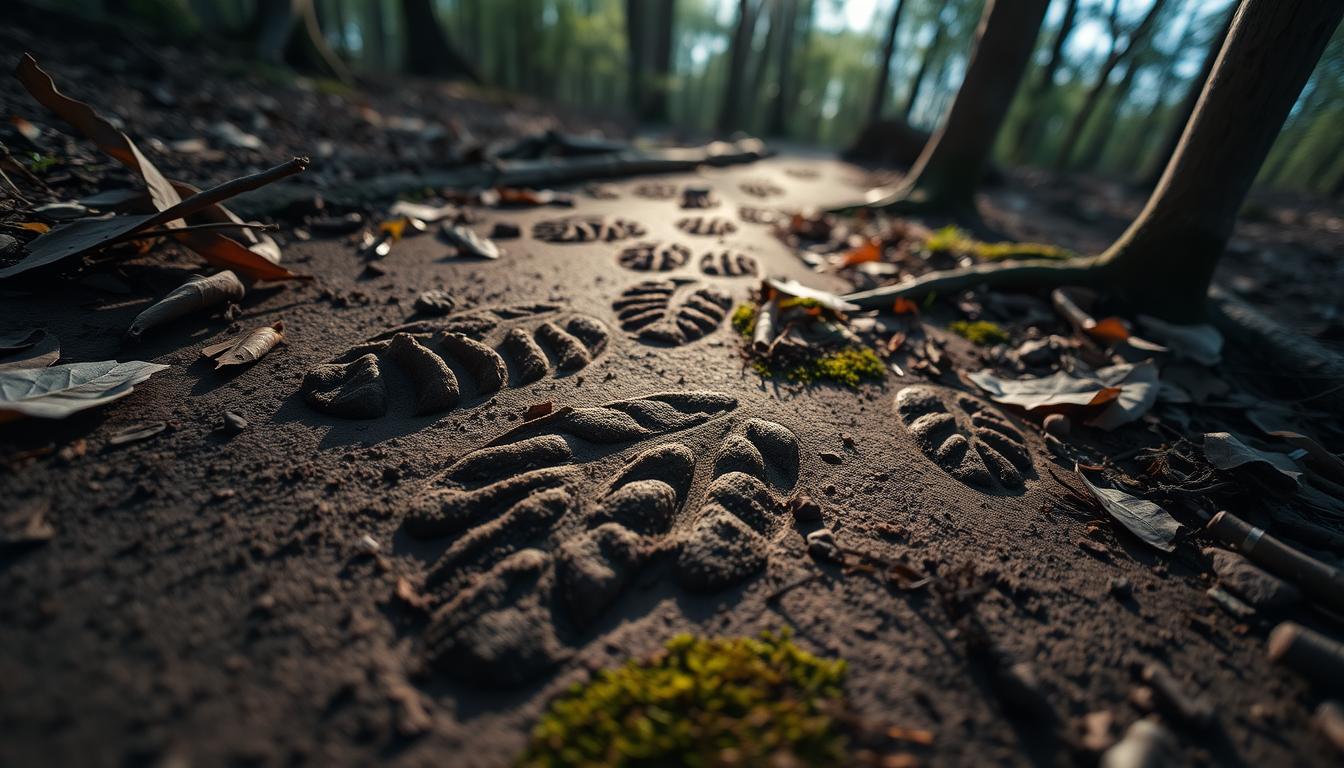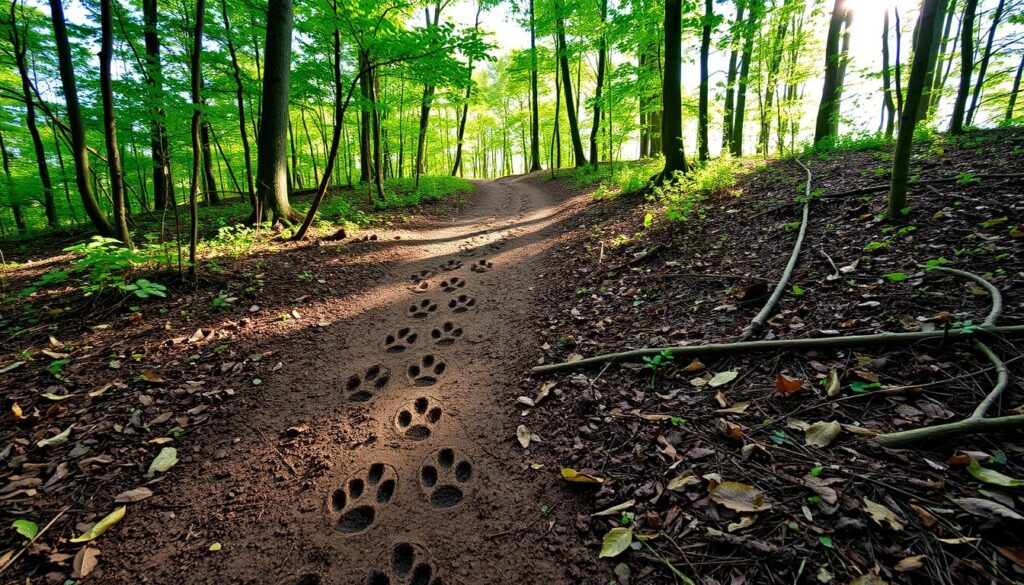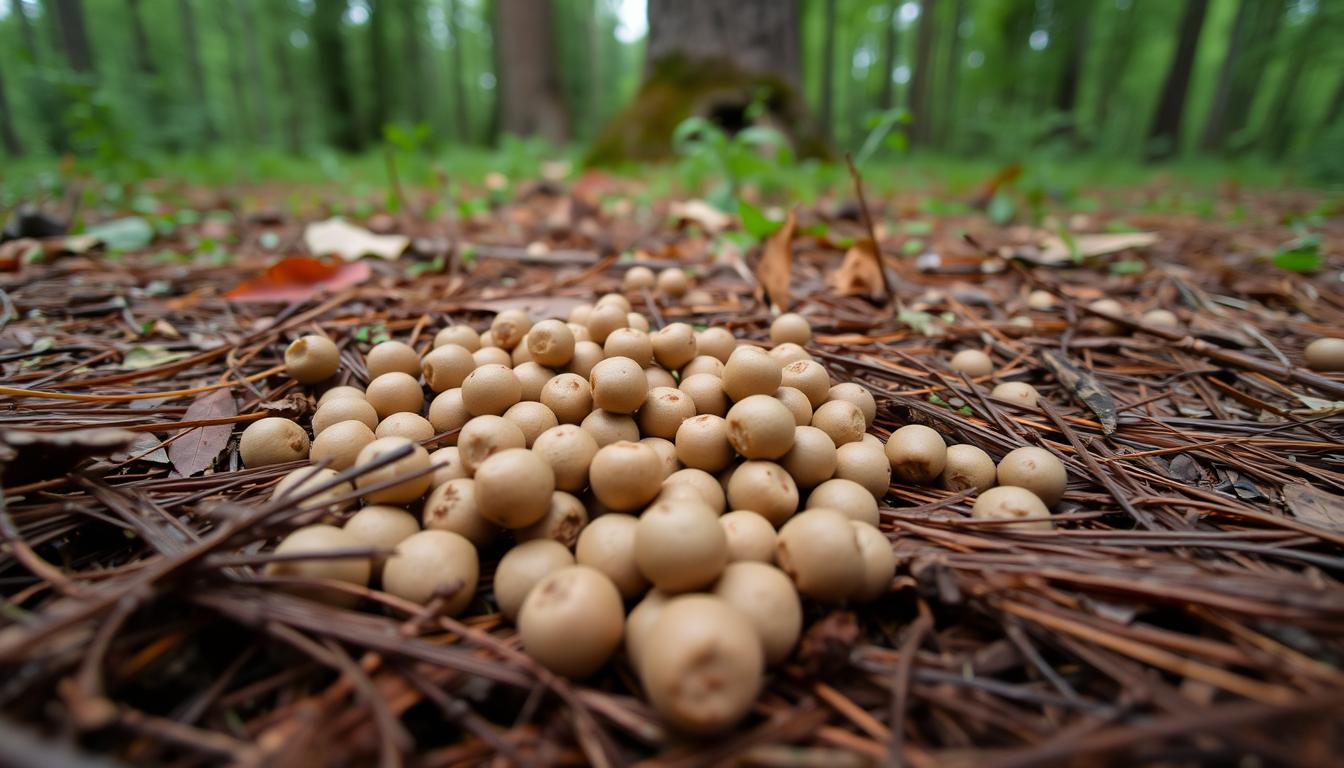Learn to Identify Fresh Deer Tracks in the Wild

Did you know deer tracks can tell you a lot about their behavior? A single set of tracks can show if a deer was walking or running. About 70% of experienced hunters say their success comes from tracking skills, especially in identifying deer tracks. These tracks help find where deer move and where they eat1.
Learning to read these tracks can change the game. It lets you understand deer habits better and hunt more successfully.
This guide will teach you about deer tracks, focusing on fresh ones in the wild. You’ll learn how to tell a buck from a doe and what makes a track fresh. You’ll also learn techniques to uncover the secrets of the tracks you find. Whether you’re new or experienced, mastering wildlife tracking can make your outdoor adventures better.
Key Takeaways
- Understanding deer tracks is crucial for tracking deer effectively.
- Fresh tracks offer insights into the behavior and movement of deer.
- Monitoring soil conditions can enhance your ability to identify fresh tracks accurately.
- Recognizing the differences between buck and doe tracks is key for hunters.
- Practicing your tracking skills can improve your overall hunting success.
Understanding the Importance of Identifying Deer Tracks
Knowing how to spot deer tracks is key to understanding their behavior. This includes their eating habits and when they mate. It helps you track wildlife better and increases your hunting success. Spotting deer trail signs lets you guess where they’ll move next, making your time outdoors better.
Learning to identify these tracks deepens your connection with nature. Not recognizing them means missing out on important deer information. Adult deer tracks are 1 to 4 inches long and .75 to 2.8 inches wide2. Knowing these sizes helps you figure out which deer you’re seeing and where they live.
When tracking, look for dew claws in mud or snow. They help tell deer tracks apart. Deer usually leave tracks in pairs, with a gap of 13 to 26 inches between them2. These details make your hunting trips more rewarding.
Basics of Deer Track Patterns
Learning about deer track patterns is key for tracking deer in the wild. Deer tracks are V-shaped due to their foot structure. The size and depth of a deer footprint change based on species, age, and sex. For example, buck tracks are over 5 inches long, while fawn tracks are small, like tiny triangles3.
Deer tracks show their behavior. A direct register pattern means the deer moved forward. The typical pattern is a zig-zag trail, with each foot touching the ground in sequence. An indirect pattern shows the deer moved in a common way, seen in both wild and domestic deer4.
Noticing the differences in deer track patterns helps understand their behavior and energy. Deep impressions mean the deer jumped a lot. Wide ridges between tracks show sharp turns during fast movements. Knowing these details helps in tracking deer and finding their paths4.
To learn more about identifying fresh tracks, check out the Deer Tracking Guide. It provides practical tips for spotting deer tracks and understanding their meaning in the wild.
How to Differentiate Between Buck and Doe Tracks
Knowing how to spot deer tracks is key for wildlife lovers. To tell buck from doe tracks, look at size and shape. A close look at deer hoof prints helps make accurate guesses.
Size Differences in Tracks
Track size is a big clue. Buck tracks are bigger, about 5 to 6 inches long. Doe tracks are smaller, from 1.5 to 4 inches. This size gap is crucial for identifying deer tracks right.
Older bucks have even bigger front tracks than does. This can be a big clue that the track is from a buck5. Knowing these sizes helps you tell the difference between the sexes.
Shape Characteristics
Track shape is also important. Buck tracks are wider and squarer, while doe tracks are more pointed6. Looking at track shapes can tell you a lot about deer behavior.
Bucks often drag their feet, while does lift them. This makes their tracks different5. This behavior helps you figure out which tracks are from bucks or does. Deer move differently in different places.
Identifying Fresh Deer Tracks
Finding fresh deer tracks is key for wildlife fans and hunters. Knowing what makes a track fresh is important. Fresh tracks have sharp edges and don’t show signs of drying or erosion7. The conditions under which tracks are made affect how long they stay visible.
What Makes a Track Fresh?
Fresh tracks have a unique upside-down heart shape and convex sides8. Tracks less than 12 hours old are great for tracking, showing where the deer was recently7. Older tracks have rounded corners and are less sharp.
Think about the weather and ground when checking track freshness; mud keeps tracks visible longer than hard soil.
Using Soil Conditions to Your Advantage
Soil type greatly impacts track visibility. Mud keeps moisture longer, making tracks more visible7. Rain makes tracks easier to spot. Knowing about different soils helps find fresh tracks. In snow, warm weather melts tracks, while cold mornings keep them sharp7.
| Soil Type | Track Longevity | Conditions Affecting Freshness |
|---|---|---|
| Mud | Months to years | Remains visible even after aging |
| Snow | Weeks | Lasts until significant weather events |
| Sand | Hours to days | Quickly eroded by sun and wind |
Working with experienced trackers and using field guides can improve your skills8.
Recognizing Different Types of Deer Tracks
Understanding the types of deer tracks is key when tracking wildlife. Each track tells us about deer behavior and how they move. Walking tracks are clear and don’t disturb the soil much. Running tracks, however, are deeper and show soil displacement, showing the deer’s speed.
Bedding and feeding tracks reveal where deer rest and eat. These tracks often come with other deer trail signs like droppings or nibbled plants. Knowing these signs helps you track wildlife better and enjoy the outdoors more.
Adult deer tracks are 2 3/8 to 3 1/4 inches long, while fawn tracks are about 1 3/8 inches9. Knowing these sizes helps you tell adult from young deer tracks.
Deer Hoof Prints: An Overview of Their Structure
Learning about deer hooves is key for tracking and identifying them in the wild. Deer hoof prints are unique, showing how they move and even their species. Each hoof has two main toes and two small dewclaws at the back. These details help spot and age tracks accurately.
Anatomy of Deer Hooves
Deer hoof print sizes differ by species. Front hooves are about 7.62 x 3.97 cm (3″ x 1 9/16″ in), and rear ones are 7.3 x 3.81 cm (2 7/8″ x 1 1/2″ in)10. Bucks, being larger, leave bigger prints because their hooves spread more when they hit the ground. Alastair’s study shows dewclaws on hind feet are farther back than on front feet10. This is key for track interpretation.
The Role of Dewclaws in Tracking
Dewclaws are crucial for tracking deer. In soft soil, their imprints are clear, showing a deer’s activity and behavior. Alastair found that the outside toe is usually longer than the inside one in most cases. In a study of 12 legs, nine had longer outside toes, two had longer inside toes, and one had equal lengths10.
Tracking deer reveals more than just footprints. The details of their hooves help identify species and even individual deer. This skill makes tracking more rewarding and connects us closer to nature.
Understanding the Behavior Reflected in Tracks
Wildlife tracking lets us see a lot about deer behavior through their tracks. Each track tells us about their movement and direction. For example, feeding deer have longer strides and scattered tracks, showing they’re relaxed. Tracks that look rushed might mean a deer is scared and running away.
Deer like to live in forests near water, which changes how they move and track11. Their tracks also change with the seasons, like during spring mating. Knowing this helps us understand their activities and predict their behavior11.
Looking at the context of a track helps us understand deer behavior. Details like the number of toes and track shape tell us about the deer and its survival12. This knowledge is key for wildlife photography, helping us capture deer in their natural setting without disturbing them11.
Deer tracks can show their emotional state too. For example, tracks in single or double file suggest social behaviors. The size and shape of tracks also vary by species. Whitetail tracks are smaller, while mule tracks are larger. This helps us identify the deer and its behavior patterns13.
Techniques for Accurately Measuring Deer Tracks
Measuring deer tracks is key to knowing the size and type of deer in your hunting area. You need the right tools and techniques for accurate identification. Precise methods help figure out deer size, age, and weight.
Tools for Measuring Tracks
For measuring deer tracks, use a flexible or steel tape measure. These tools help you get exact distances. Key measurements include the width between the front toes and the length from the toe tip to the dewclaw.
Hal Blood says to look for a 3-inch by 3-inch hoof print to spot a big buck track in the Northeast14. Tracks that are 8 to 12 inches wide side to side usually mean a healthy deer, with 12 inches being the best14.
Interpreting Measurements for Size Estimates
Understanding measurements can give you insights into deer size and behavior. Tracks with drag marks in snow an inch or two deep often belong to mature bucks. This is because older deer lift their feet less14.
Also, tine marks in the snow show where deer have fed. This helps guess the buck’s maturity14. Todd Havel notes that big bucks usually go around obstacles, looking for easier paths. This helps in identifying mature deer through track analysis14.
Identifying Deer Trails and Signs in the Wilderness

When you start tracking wildlife, finding deer trails is key. It helps you understand their behavior and where they go. Deer trails are usually narrow and V-shaped, showing where they like to move.
They often choose to go under obstacles rather than over them. This makes their paths easy to spot in the underbrush15. Besides tracks, signs like scrapes, droppings, and rubs on trees tell you a lot about deer activity.
Deer scat can tell you about their diet. It’s dark brown and can be as small as a plum pit or as big as a peach pit15. It has one nippled end and one indented end. Deer feeding on trees can also leave marks, showing what they eat.
These marks are usually no wider than 3/16 of an inch and are not higher than 6 feet15. The trails you find might also show where deer bed down. Here, the ground is thicker, so their tracks are less clear.
By carefully watching these trails and signs, you can learn a lot about the deer in your area. This knowledge can help you during hunting or just enjoying nature. Understanding deer trails and behavior makes tracking wildlife more rewarding16.
| Trail Type | Shape | Width | Common Signs |
|---|---|---|---|
| Narrow Trail | V-shaped | 1-4 inches | Tracks, Scat, Rubs |
| Feeding Area | Irregular | Varies | Gnawing Marks, Scat |
| Bedding Area | Less Defined | Varies | Flattened Vegetation, Droppings |
How to Age Deer Tracks in the Field
Aging deer tracks means knowing what makes them look different. It’s about understanding how things like soil, weather, and the deer’s age affect their tracks. These factors can change how clear or worn the tracks are.
Factors That Affect Aging Tracks
Fresh tracks have sharp edges and clear marks in the ground. Over time, weather like rain or wind can wear them down. Older tracks might have faded edges and look more squished.
This change helps you guess how long ago a deer was there.
Signs of Old Tracks vs. Fresh Tracks
When looking at signs of old tracks, think about the soil and weather. Fresh tracks are clear and deep, while older ones are shallower and less sharp. Here’s a quick guide:
| Track Age | Characteristics |
|---|---|
| Fresh Tracks | Defined edges, clear shape, softer impression in soil |
| Aging Tracks | Softer edges, shallower depth, evidence of weathering |
| Old Tracks | Faded appearance, less recognizable, compacted soil |
Noticing these differences can help you understand deer movement. Knowing the difference between fresh and signs of old tracks can improve your hunting or wildlife watching. For more on animal care and welfare, check out this guide on enhancing animal well-being17.
Practical Tips for Wildlife Tracking
Wildlife tracking needs sharp eyes and patience. By sticking to one spot, you learn more about local animals. Regular visits help spot patterns and habits, showing the value of long-term watching18.
This method boosts your skills in recognizing deer tracks. It also gives deeper insights into animal behavior.
While tracking, look for signs like droppings and feeding marks. For example, stripped bark or fallen leaves hint at deer presence19. Knowing how seasons affect deer movement is key. Adjust your tracking plans to match these changes for better results.
Improving at deer track identification takes practice in various settings. Always be quiet and alert. This helps a lot in successful tracking18. After tracking, making maps and using resources can help understand wildlife patterns and habitats.
Using Trail Cameras to Complement Track Identification
![]()
Trail cameras are key for deer tracking, offering insights into deer behavior. They capture images of deer during their most active times, like late evenings and early mornings. This helps you better identify deer tracks and understand their patterns20.
Trail cameras cost between $130 and $500, making them affordable for many hunters21. They can run up to 150 days and store over 1,000 images, thanks to battery-saving tech. It’s best to set them 3-4 feet off the ground for clear images21.
Trail cameras also help find the best hunting spots. To track deer effectively, follow these tips:
- Set clear objectives for your hunts to stay focused.
- Check the camera regularly for battery life and image retrieval.
- Use one camera per 160 acres to cover more ground21.
- Move camera positions every 10 days for better tracking21.
Using trail cameras can greatly boost your hunting success. They offer detailed insights that complement the information from physical tracks20.
Conclusion
Learning to identify deer tracks boosts your wildlife tracking skills and makes outdoor adventures more exciting. Knowing how to spot deer footprints helps you make better decisions while hunting. This knowledge lets you move through different terrains, like dense woods or open fields, effectively.
As you get better at spotting and understanding deer tracks, you’ll see more than just footprints. You’ll learn about a deer’s behavior, how it moves, and its health. It’s important to remember the deer population and how the environment affects them when tracking22.
With the right tools and observation, you can use what you learn about animal behavior in the wild. This journey into tracking opens up new experiences and successes on your hunts. It deepens your connection to the wildlife around you23. Your tracking adventure is just starting, and there’s a lot more to explore.
FAQ
How can I tell if deer tracks are fresh?
What is the difference between buck and doe tracks?
What tools do I need to measure deer tracks accurately?
How can I identify different types of deer tracks?
Why is it important to understand deer behavior through tracks?
How do soil conditions affect deer track identification?
How can I use trail cameras in conjunction with tracking deer?
What should I look for when identifying deer trails?
How do I age deer tracks in the field?
Source Links
- https://blog.carbontv.com/2024/07/03/deer-tracks/ – Deer Tracks: Here’s What They Tell You | Images and Expert Tips
- https://nature-mentor.com/deer-tracks/ – Deer Tracks And What They Tell You (ID, Speed, Direction, etc)
- https://www.zerotohunt.com/deer-sign-guide-how-to-scout-for-deer/ – Deer Sign Guide | How to Scout for Deer – Zero to Hunt
- https://lindajspielman.com/2019/08/19/a-closer-look-at-deer-tracks/ – A Closer Look at Deer Tracks
- https://naturetracking.com/buck-vs-doe-tracks/ – How to Tell Buck from Doe Tracks
- https://www.differencebetween.net/science/nature/difference-between-doe-and-buck/ – Difference Between Doe and Buck
- https://nature-mentor.com/how-to-tell-if-animal-tracks-are-fresh/ – How To Tell If Animal Tracks Are Fresh (sand, mud & snow)
- https://www.wildernesscollege.com/identify-deer-tracks.html?srsltid=AfmBOoqutS1O77kYOsvQmGCK6kZssMtlpX8vBW22c1EYPxPc9b-WqkP1 – How to Identify Deer Tracks From Other Similar Footprints
- https://pubs.nmsu.edu/_circulars/CR561/ – Identifying and Preserving Wildlife Tracks | New Mexico State University
- https://www.toknowtheland.com/blog/whatthetoesshow – What The Toes Show – A question of deer hooves — to know the land
- https://marksoutdoors.com/blogs/marks-outdoor-blog/the-basics-of-animal-tracking – The Basics of Animal Tracking
- https://nature-mentor.com/what-animal-tracks-tell-us/ – What Do Animal Tracks Tell Us?
- https://deerdonkey.com/deer-tracks/ – Deer Tracks: The Ultimate Guide for 2024 Success
- https://www.themeateater.com/wired-to-hunt/whitetail-scouting/how-to-identify-a-big-buck-track-in-snow – How to Identify a Big Buck Track in Snow
- https://wildernessawareness.org/articles/black-tailed-deer-tracks-and-sign/ – Black-tailed Deer Tracks and Sign » Wilderness Awareness School
- https://perseverancesurvival.com/deer-tracks-direction-how-to-read-tracks-like-a-skilled-tracker/ – Deer Tracks Direction – How to Read Tracks Like a Skilled Tracker?
- https://deerlab.com/blog/how-to-age-a-deer – How to Age a Deer and Why It’s Important
- https://nature-mentor.com/deer-tracking/ – How To Learn About Local Deer With Tracking
- https://bushcraftuk.com/wildlife-tracking-a-beginners-guide/ – Wildlife Tracking: A Beginner’s Guide
- https://gunwraps.com/blogs/hunting-tips-1/a-beginner-s-guide-to-tracking-deer – A Beginner’s Guide to Tracking Deer | GunWraps Blog
- https://nri.tamu.edu/media/1073/potential_use_for_trail_cameras.pdf – PDF
- https://learningcorner.co/explain-anything/3174 – A Step-by-Step Guide / Learning Corner
- https://www.findahunt.com/differentiating-deer-tracks-from-whitetails-to-mule-deer – From Whitetails to Mule Deer



